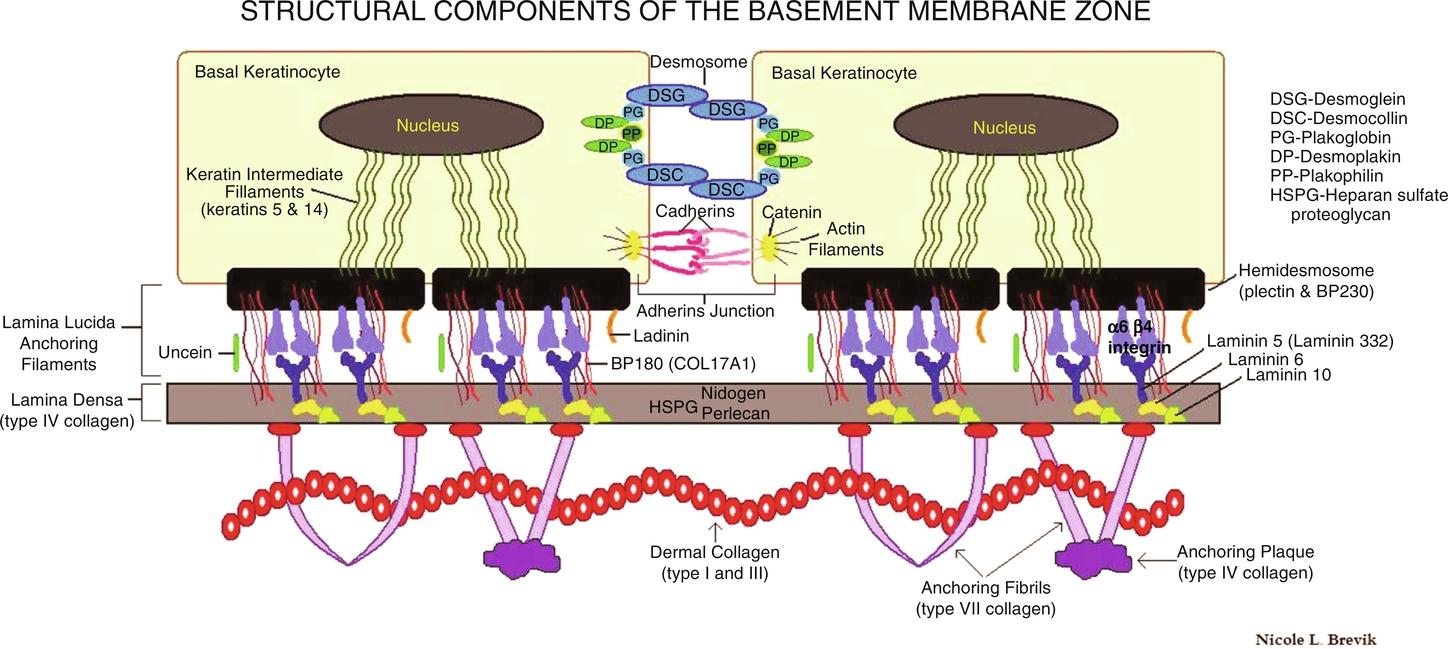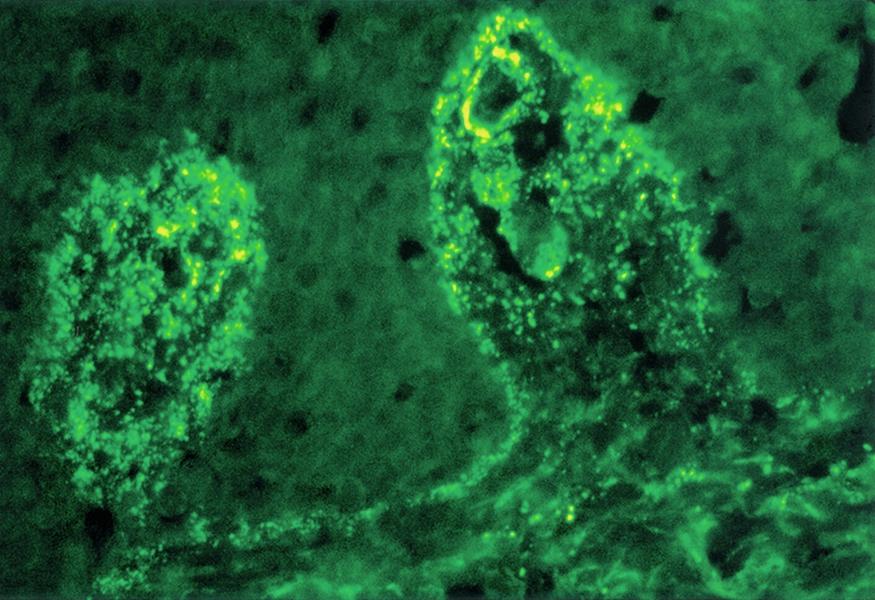Physical Address
304 North Cardinal St.
Dorchester Center, MA 02124
Size. If a blister is less than 5 mm in diameter, it is referred to as a vesicle. If a blister is 5 mm or larger, it is called a bulla. Some dermatologists require bulla be 1 cm or larger. The term “vesiculobullous” may be used for blistering disorders, as it encompasses blisters of varying size.
Bullous diseases are characterized by blisters (skin lesions that contain fluid) that may arise at various depths in the epidermis and dermis. Often, the depth at which a blister forms can be used to classify the disorder. “Intraepidermal” refers to blisters that arise within the epidermis, while “subepidermal” refers to blisters that arise beneath the epidermis ( Table 10.1 ). Some blistering disorders develop because of autoantibodies directed against a component of the epidermis or basement membrane zone (“autoimmune bullous conditions”), while others develop because of structural defects of skin components (“congenital blistering disorders”). Refer to Fig. 10.1 for the location of these components in normal skin, as they are discussed in the following questions.
| Intraepidermal blisters | Subepidermal blisters |
|---|---|
| Allergic contact dermatitis (spongiotic) Bullous dermatophyte infection (spongiotic) Herpes simplex (intraepidermal acantholytic) Herpes zoster/varicella (intraepidermal acantholytic) Bullous impetigo (subcorneal) Miliaria crystallina (subcorneal) Epidermolysis bullosa simplex (mechanobullous) Pemphigus vulgaris (suprabasilar acantholytic) Pemphigus foliaceus (subcorneal acantholytic) Paraneoplastic pemphigus Hailey-Hailey disease (intraepidermal acantholytic) Incontinentia pigmenti (spongiotic) Epidermolytic ichthyosis (mechanobullous) |
Porphyria cutanea tarda Bullous pemphigoid Cicatricial pemphigoid Dermatitis herpetiformis Linear IgA bullous dermatosis Bullous systemic lupus erythematosus (SLE) Epidermolysis bullosa acquisita Dystrophic epidermolysis bullosa Junctional epidermolysis bullosa Anti–p200 pemphigoid Anti–p105 pemphigoid |

Blisters of the skin may be caused by a wide variety of external agents and/or diseases, including trauma, infections, metabolic disorders, genetic deficiencies, and inflammatory diseases, to name a few. Blisters caused by infections are discussed in Chapters 25 (viral) and 27 (bacterial).
History is important in the evaluation of a blistering skin disorder. Acute onset of blisters may suggest an exposure to a contact allergen, arthropod bites, phototoxic agents, or other drugs or chemicals, trauma, or infectious agents. Some chronic vesiculobullous diseases may have an acute onset, but then may persist or recur ( Table 10.2 ).
| Acute | Chronic |
|---|---|
| Allergic contact dermatitis Arthropod bites Drug eruptions (may become chronic if drug is not withdrawn) Erythema multiforme (may recur, especially with herpes simplex) Hand, foot, and mouth disease Herpes simplex Varicella-zoster virus Impetigo Miliaria crystallina Physical-, thermal-, or chemical-induced blisters Toxic epidermal necrolysis Stevens-Johnson syndrome |
Bullous pemphigoid Bullous systemic lupus erythematosus Cicatricial pemphigoid Dermatitis herpetiformis Epidermolysis bullosa acquisita Linear immunoglobulin A bullous dermatosis Pemphigus foliaceus Pemphigus vulgaris Genetic blistering diseases |
Important features of a blistering disorder include the skin distribution, assessment of symmetry, involvement of mucosal surfaces, and associated lesions (such as erosions, ulcers, and crusts). Other types of skin lesions, such as urticaria, should be sought. For example, in bullous pemphigoid (BP), urticarial lesions often precede the development of blisters. In some vesiculobullous diseases, such as dermatitis herpetiformis (DH), only excoriations may be present, without intact blisters.
Characteristics of the blister may be important. Flaccid blisters may indicate a more superficial blistering process than is seen with tense blisters, but the anatomic site must also be considered. Blisters on acral skin, with a thick stratum corneum, may appear tense, even if superficial. In some other diseases, like toxic epidermal necrolysis, full-thickness sloughing of the skin can make it challenging to recognize vesiculation.
DH is a disorder that affects chiefly the knees, elbow, buttock, and posterior scalp. Table 10.3 details some classic patterns of distribution.
| Disease | Characteristic distribution |
|---|---|
| Acrodermatitis enteropathica | Acral, periorificial |
| Allergic contact dermatitis | Reflects pattern of contact; often linear |
| Bullous dermatophyte infection | Feet, hands |
| Bullous diabeticorum | Distal extremities |
| Bullous pemphigoid | Flexural areas, lower extremities |
| Cicatricial pemphigoid | Eyes, mucous membranes |
| Dermatitis herpetiformis | Elbows, knees, buttocks |
| Erythema multiforme | Acral areas, palms, soles, mucosa |
| Hailey-Hailey disease | Intertriginous areas, neck |
| Hand, foot, and mouth disease | Mouth, palms, fingers, soles |
| Herpes zoster | Dermatomal distribution |
| Linear immunoglobulin A bullous dermatosis (childhood type) | Groin, buttocks, perineum |
| Pemphigus vulgaris | Oral mucosa, head, trunk, other sites |
| Pemphigus foliaceus | Head, neck, trunk |
Diagnostic tests for vesiculobullous eruptions are often performed on the blister itself. When infectious causes are considered, appropriate cultures (aerobic bacteria, viruses, fungi) may be obtained. Provider-performed microscopy, such as a Tzanck smear, can reveal multinucleate keratinocytes in Herpes viridae family infections. For noninfectious vesiculobullous diseases, a skin biopsy is often a useful test.
An early lesion should be biopsied to avoid secondary changes that can confound histologic examination. A small, intact blister is ideal, as the entire lesion and some of the surrounding skin can be removed intact, using a saucerization or excision technique. If a punch technique is employed, it is best to sample from the edge of the blister overlapping onto normal skin. The specimen should be placed in 10% neutral-buffered formalin (NBF) unless direct immunofluorescence studies are desired (see below). Appropriate clinical information, including the age/sex of the patient, a clinical description of the appearance and distribution of lesions, associated symptoms, exacerbating factors or relieving treatments, and a solid clinical differential diagnosis should be provided with the specimen.
A skin biopsy for direct immunofluorescence may be helpful in including or excluding immunobullous diseases ( Table 10.4 ). Direct immunofluorescent (DIF) technique uses special fluorescent antibodies directed against immunoglobulin G (IgG), IgA, IgM, C3, and fibrin that are detected in tissue with a special fluorescent microscope ( Fig. 10.2 ). Immunofluorescent mapping, electron microscopy, or genetic studies may be necessary to diagnose some blistering conditions. Other tests to consider in special circumstances may include urine, serum, or stool porphyrin tests when porphyria is being considered or zinc levels, glucagon levels, or hepatitis panels when necrolytic erythemas are suspected.
| Disease | Target antigen | Direct immunofluorescence findings |
|---|---|---|
| Bullous pemphigoid | BP180, BP230 | Linear C3, IgG at DEJ |
| Bullous SLE | COL7A1 | Linear/granular IgG, other Igs at DEJ |
| Cicatricial pemphigoid | BP180, LAM5, and others | Linear C3, IgG, IgA at DEJ |
| Dermatitis herpetiformis | eTG | Granular IgA, C3 in upper dermis (see Fig. 10.1 ) |
| Epidermolysis bullosa acquisita | COL7A1 | Linear IgG, IgA, other Igs at DEJ |
| Herpes gestationis | BP180 | Linear C3, IgG at DEJ |
| Linear IgA bullous dermatosis | BP180, COL7A1, LAD | Linear IgA, C3 at DEJ |
| Pemphigus foliaceus | DSG1 | IgG, C3 in intercellular spaces |
| Pemphigus vulgaris | DSG3 (mucous membrane only) DSG3 and DSG1 (mucous membrane and skin) |
IgG, C3 in intercellular spaces |
| IgA pemphigus | DSC1, DSG1, DSG3 | IgA in intercellular spaces |
| Paraneoplastic pemphigus | DSG1, DSG3, DP1, DP2, BP180, BP230, EP, PP, γ-catenin (PG), plectin, 170 kDa, DSC2, DSC3 | IgG, C3 in intercellular spaces, DEJ |
| Porphyria cutanea tarda | None (not antibody mediated) | Homogeneous IgG at DEJ and around vessels |
| Anti–p200 pemphigoid | 200-kDa antigen | IgG, C3 at DEJ |
| Anti–p105 pemphigoid | 105-kDa antigen | IgG, C3 at DEJ |

van Beek N, Zillikens D, Schmidt E. Diagnosis of autoimmune bullous diseases. J Dtsch Dermatol Ges. 2018;16:1077–1091. https://doi.org/10.1111/ddg.13637 .
Become a Clinical Tree membership for Full access and enjoy Unlimited articles
If you are a member. Log in here